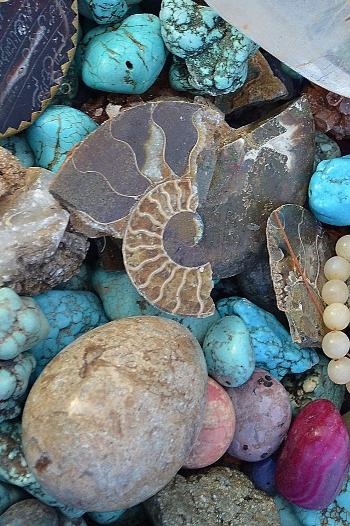Storytelling stones
Duration/age

There are many different ways that we share stories. It can be by talking, by showing them in a painting, drawing, weaving, or design, in photographs or by using the natural environment.
One way to help your child tell and listen to stories is to use stones. When you use stones to tell stories the tale changes, taking on many possibilities and personalities that are not just words or pictures on a page. The picture, colour or pattern on the stone becomes a page in a story.
Go on a hunt around your yard or neighbourhood to help your child find stones for telling stories. If you are going to paint them or make designs on them, you will need to pick stones that are flat and smooth. If you want to tell stories about people or families you will need to pick stones that are different shapes and sizes.
Should we decorate the stones? Or just leave them plain?
As you play with the stones your child will naturally take the lead on how they want to use them to tell stories.
Your child might have a favourite storybook that they like to read. You could create designs on the stones that match the pages of the book and as you read your child can create the story by placing the stones that match the page.
Your child might want to create their own stories that change every time. They can use the stones to tell stories about different adventures or ideas. If the stones take on personalities, your child might want to dress the stones, add hair or create places for them to live.
Here is the first stone. Can you tell me a story?
Materials you will need
- Stones
Alternative tools
- Paint
- Glue
- Textas
- Storybook
- Collage
- Natural found objects
Skills this activity improves
Why does this matter?
When children hear and take part in storytelling they expand their language, develop listening skills and develop concepts of print. As children tell or hear stories they are learning that language can be spoken or it can be recorded through words, pictures, painting or drawing.
Children are also developing an understanding that words are combined together to make sentences and that how we combine the words together will change the tone of a story. It can change from being happy to scary.
What does this lead to?
When children are surrounded by language and stories they begin to make connections to the structure of language. Stories have a beginning, a middle and an end. They also usually have an image or picture that helps to give meaning to the words.
By telling, creating and reading stories children experience that the picture, image or design gives greater meaning to the words on the page. Usually the image will connect to the words and lead the reader to the next part of the story. The image helps the reader to understand how they should feel during the story. The colours that are used or the facial expressions shown might be there to help create a happy feeling or a sad tone.
Telling and reading stories exposes children to a wide range of literature and shows them that there are many different ways to tell and share stories and information. Stories can be about an event that has happened, just for enjoyment or can be a way to communicate new ideas or learning.
Language to use
- Family, children, mum, dad, brother, sister, aunty, uncle, grandma, grandpa
- Beginning, middle, end
- Start, finish
- Event, adventure, idea, story, sequence
Questions to use
- What will your story be about?
- Who is in the story?
- Where will they go?
- What do you need for the story?
- What happened in the story?
Useful tips
- Take a look at the SA Museum website for information and events about storytelling, stones and more.
- You can find language development information in the Child and Youth Health ‘Blue Book'.
- Try looking for interesting and new stones at your local garden centre.
- Children are natural storytellers and won't need much encouragement to share stories about the things they know, events they were involved in and their ideas.
- Remember to talk to your child in your home language.
More ideas
- Make your own book about your family.
- Take photos and glue them onto stones to use for storytelling.
- Visit the Aboriginal gallery at the Art Gallery of South Australia. Try and work out the story of the painting before reading the caption on the wall.
Variation by age
Birth to two year olds
- Make a storytelling bag that includes a book and things related to the story. It might be farm animals or Australian animals to match the characters in the book.
- Make matching cards for your child’s favourite story.
Three to five year olds
- Create a sand tray with assorted things from nature for telling stories.
- Video your child telling stories.
- Encourage your child to choose the books they want to use for telling stories.
- Explore what other natural resources could be used for telling stories. Could you use gumnuts or sticks?
Questions to ask
- What sound does a cow make?
- Which animal is bigger?
- Which animal is next?
Questions to ask
- What is this story about?
- Who are the characters in the story?
- What happens in the story?
Language to use
- Cow, sheep, pig, cat, dog,
- Kangaroo, wallaby, wombat, possum


